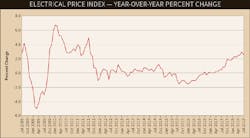Prices on electrical equipment are beginning to rise, an effect we’ve all been watching for since early in the year. The combination of new tariffs on imported raw materials and, later, finished goods — some of which have been implemented, others only threatened — have joined with rising interest rates, increases in freight costs and several other factors to stir up a flurry of price increase announcements from manufacturers.
One question is how this will affect electrical distributors and the supply channel as a whole, another is whether the broader trend will lead to a slowdown in projects. Today it’s still too soon to tell, but there are indications that rising prices are beginning to affect project timetables and budgets.
Price increases in the data. Electrical Marketing’s proprietary Electrical Price Index, a monthly measure of pricing changes across 28 electrical product categories, has begun to show signs of movement this year for the first time in a long time. After roughly seven years of essentially flat year-on-year pricing — to the point that our editors would get excited about a 0.4% increase from month to month — the total index in June and July posted 3% year-on-year increases (see chart).
Three percent looks like a small number but it’s significant because of how price changes flow through the supply chain from raw materials to installed equipment. The EPI reflects not the final purchase prices paid, but prices received by domestic producers (non-seasonally-adjusted producer prices). That reduces the import tariff impact, or spreads it over time.
Upstream price increases on raw materials take nine months to a year to show up in eroding margins for finished goods manufacturers, John Mothersole, director of research, pricing and purchasing for IHS Markit, told Electrical Wholesaling.
“The important question is what happens now. Here, copper can provide a guide,” Mothersole said. “Its plunge in the past 3-4 months means that the pressure now being felt in supply chains should begin to abate – again after a lag. Does this mean that we are out of the woods in terms of accelerating goods prices inflation? If the current sideways trend in commodity prices holds, I think it does. I tend to think copper is oversold at the moment. If this is a correct assessment, in the months immediately ahead prices are likely to bounce back a bit and then remain comparatively stable based on our read of fundamentals. On the other hand, if ‘Dr. Copper’ continues to sag, we need to begin asking the question about whether something more serious is happening to global manufacturing activity.”
Closer to the street, some manufacturers in the electrical industry have been announcing price increases to cover their rising costs and improve their own profitability. It’s not all related to materials costs and tariffs. Several lighting manufacturers have raised prices on legacy technologies over the past six months while holding down their prices in the intensely competitive and rapidly growing LED categories.
Steel-intensive products including steel conduit, strut and raceway have seen significant monthly increases from some manufacturers. Atkore International’s Unistrut, for just one example, announced increases of 10% on channel and 5% on fittings in May, 9% on channel and 5% on fittings in June, and another 12% on channel in July.
Distributors seize the opportunity. With prices rising distributors will tend to benefit as the value of their inventory increases and of course the gross margin on a bigger number is a bigger number. But how to make the best use of the opportunity is not always obvious.
In the ideal scenario, the whole market will raise prices by the same amount, but of course that won’t always happen, says industry consultant David Gordon of Channel Marketing Group, Raleigh, NC.
Gordon says there’s an important difference between passing a price increase along to customers and passing it along in a way that optimizes the distributor’s profitability. Some distributors are big enough that they can push back, negotiate their manufacturers down to a smaller increase and then go to market with the full increase. Some distributors will be held back from raising prices by existing contracts with customers. For all distributors, it can come down to whether your purchasing department is keen on negotiation, Gordon says.
“If the cost of materials went up and you can’t pass it along, do you pass on that piece of business, or do you find a way to share that incremental cost with the manufacturer?” he says.
Gordon said it’s important to involve the sales organization in the pricing discussions so they understand the lay of the land. Information on price increases tends to get communicated quickly into the market so telling customers about them isn’t likely to be shocking news. This can open opportunities for negotiations.
Price increases highlight the importance of having language in pricing contracts that give you an out in the case of price changes beyond a certain level. They also emphasize the need to have manufacturer allies you can depend on to honor project quotes.
“The key is not to disadvantage yourself,” Gordon says. “Otherwise you’re inhibiting your own profitability. Your cost of goods went up X% but you’re not passing it along.
“Management by exception and negotiation should always be an option for distributors, just not the rule,” he says.
The good news is that we’re seeing a surge in construction projects throughout the country. The volume of big projects on the boards or breaking ground has been truly impressive of late. Electrical Wholesaling’s editors gather reports on major construction projects each quarter and over the most recent quarters there has been a surge in the number to be added to the database. On the more worrying side, those projects are starting to run up against cost increases that may slow the flow.
Project Costs: How Far is Up?
Prices increases for steel and aluminum products are hitting general contractors, subcontractors and project owners, too. But they are also getting pummeled by the increased costs of lumber, fuel and other construction materials.
Yes, electrical distributors, manufacturers and independent manufacturers reps have plenty to kvetch about when it comes to the increases in steel and aluminum prices and the wild ride that copper prices have been on over the last few months.
But they don’t have it nearly as bad as builders or suppliers and manufacturers that live and die with the prices of other construction-related products in the supply chain. These poor folks are not only getting whacked by double-digit increases in prices for steel products like rebar and framing materials, aluminum products like window frames, #2 diesel fuel, asphalt and lumber, but also labor shortages throughout the construction trades often derailing the construction schedules for all sorts of projects. On top of rising materials costs and labor shortage, hopped-up end user demand for new buildings and renovations in a healthy construction market is also fueling the increases.
HIGHER COSTS OF MATERIALS INCREASE PROJECT PRICES
While few contractors are willing to say increases in project costs are solely due to the current 25% tariff on steel and 10% tariff on aluminum because of the other contributing factors mentioned above, there’s little doubt they are at least a contributing factor. An August post at www.king5.com and a recent Bloomberg report said two major construction projects in Seattle are way over budget because of materials costs and the labor shortage. A representative from the Oak View Group, a Los Angeles-based developer working on a new arena at Seattle Center, said the cost for that facility had gone up from $600 million to $700 million, in part because of higher steel costs. And the Federal Way Link Light Rail project is also way over budget, according to a post at www.king5.com. “We’re looking at about a $460 million increase in that project estimate,” Scott Thompson of Sound Transit said in the post. “Material costs have risen, and right now we’re looking at the risk and challenges on tariffs like steel and aluminum as well.”
The Associated General Contractors of America (AGC), Arlington, VA, is quite concerned with the impact of the tariffs on its members and has been publishing regular reports on increases in prices for core construction products. And while the price increases seem to have simmered down some in mid-August from where they were in 2Q 2018, Ken Simonson, AGC’s chief economist, said they are still having a big impact on the construction industry and the profits of AGC members. Simonson said in a recent AGC press release, “Although price changes for construction materials in July were mixed, contractors are likely to be hit with additional cost increases as new tariffs take hold and stocks of items purchased before the tariffs are used up,” he said. “Despite the pause in cost increases in July, prices for goods and services used in construction rose over the past year at more than double the rate that contractors have raised their bid prices to put up new buildings.”
He also said in the press release that the producer price index for inputs to construction industries — a weighted average of all goods and services used in construction (including items consumed by contractors, such as diesel fuel)—was unchanged from June to July but jumped +8.1% since July 2017. “Steel, aluminum and Canadian lumber are all subject to stiff new tariffs, with the prospect that prices will soon rise even more for these and other goods used in construction,” Simonson said in the release. “In addition, the cost of delivering goods and equipment to construction sites, operating diesel-powered equipment, and hauling away dirt, debris and equipment is affected by fast-rising prices for fuel and trucking services.”
Despite the current respite from more dramatic price hikes, some key construction-related products are still saddled with eye-catching year-over-year increases, as measured by the U.S. government’s Producer Price Index (PPI). The AGC release noted several of the products with the biggest gains through July 2018, including diesel fuel, metals and wood products:
• Diesel fuel: +43.6%
• Aluminum mill shapes: +17.8%
• Lumber and wood plywood: +16.3%
• Steel mill products: +12.4%
TARIFFS ON CANADIAN LUMBER HAMMER HOMEBUILDERS
In the homebuilding market, construction of single-family homes and multi-family apartments, condos and townhouses is so healthy in many markets that builders can’t find enough skilled framers, masons, plumbers, electricians and other craftsmen. And the tariffs on Canadian lumber has driven up prices. In the Eye On Housing blog published by the National Association of Home Builders (NAHB), Washington, DC., David Logan wrote, “July marked the first time in seven months that the price index for residential construction inputs (goods) did not increase. Still, the index has risen 5.4% in 2018, more than quadrupling the year-to-date increase at this time in 2017.
“Since January 2017, the index for prices paid for goods inputs to residential construction has only declined twice — in May and December of 2017 — each time falling just 0.1%.
“As expected, the July Producer Price Index release captured the decreases in prices paid for softwood lumber that began in mid-June. This was only the second month in 2018 in which the index for softwood lumber has declined. Even after accounting for the most recent price movements, the average price paid for softwood lumber in 2018 remains the highest on record according to Random Lengths (www.randomlengths.com) data — 22.8% above the prior record set in 1997.”
And according to a report posted at www.housingwire.com, Robert Dietz, NAHB’s chief economist, told attendees at the recent National Association of Real Estate Editors conference in Las Vegas that the 20% tariffs the Trump Administration slapped on Canadian softwood lumber last year have increased the average cost of a new home for home buyers. www.housingwire.com reported that Dietz said, “A lumber tariff is very much a tax on homeowners and renters. In fact, it’s pushed up the price of a typical newly built home, according to our survey data analysis, by about $9,000. It’s pushed up the price of a typical apartment by about $3,000.”
NAHB has lobbied the Administration on this issue. NAHB Chairman Randy Noel, a custom home builder from LaPlace, LA, said in a recent NAHB press release, “We have been warning the Administration for months that the ongoing increases in lumber prices stemming from both the tariffs and profiteering this year are having a strong impact on builders’ ability to meet growing consumer demand,” said, “This is why we continue to urge senior officials to take leadership and resolve this issue.”
RISING COST OF STEEL AND ALUMINUM TAKE BITE OUT OF BIG APPLE’s CONDO CRAZE
A recent article in the New York Times said the steel and aluminum tariffs are having a direct impact of the cost of materials used to build apartments and condos in the city — and are driving up sale prices. According to the article, a 20-story apartment building can require 1.5-million pounds of rebar, and prices for domestic raw rebar through late July had increased 15% to 39 cents/pound from 34 cents/pound earlier in 2018. New York builders are getting squeezed by aluminum prices, too, the article reported.
That same apartment building may also require 150,000 pounds of aluminum, (largely for window frames), and aluminum prices were up 32% from March to April before settling down to somewhat more manageable levels this summer.
Construction industry veterans have been through whacky pricing cycles before, and these cycles always inject a certain amount of uncertainty and delays in the market because contractors from all the building trades can’t get workable idea of what materials will cost and how long quotes for materials will be in effect.
About the Author
Jim Lucy
Editor-in-Chief of Electrical Wholesaling and Electrical Marketing
Jim Lucy has been wandering through the electrical market for more than 40 years, most of the time as an editor for Electrical Wholesaling and Electrical Marketing newsletter, and as a contributing writer for EC&M magazine During that time he and the editorial team for the publications have won numerous national awards for their coverage of the electrical business. He showed an early interest in electricity, when as a youth he had an idea for a hot dog cooker. Unfortunately, the first crude prototype malfunctioned and the arc nearly blew him out of his parents' basement.
Before becoming an editor for Electrical Wholesaling and Electrical Marketing, he earned a BA degree in journalism and a MA in communications from Glassboro State College, Glassboro, NJ., which is formerly best known as the site of the 1967 summit meeting between President Lyndon Johnson and Russian Premier Aleksei Nikolayevich Kosygin, and now best known as the New Jersey state college that changed its name in 1992 to Rowan University because of a generous $100 million donation by N.J. zillionaire industrialist Henry Rowan. Jim is a Brooklyn-born Jersey Guy happily transplanted with his wife and three sons in the fertile plains of Kansas for the past 30 years.
Doug Chandler
Senior Staff Writer
Doug has been reporting and writing on the electrical industry for Electrical Wholesaling and Electrical Marketing since 1992 and still finds the industry’s evolution and the characters who inhabit its companies endlessly fascinating. That was true even before e-commerce, LED lighting and distributed generation began to disrupt so many of the electrical industry’s traditional practices.
Doug earned a BA in English Literature from the University of Kansas after spending a few years in KU’s William Allen White School of Journalism, then deciding he absolutely did not want to be a journalist. In the company of his wife, two kids, two dogs and two cats, he spends a lot of time in the garden and the kitchen – growing food, cooking, brewing beer – and helping to run the family coffee shop.


